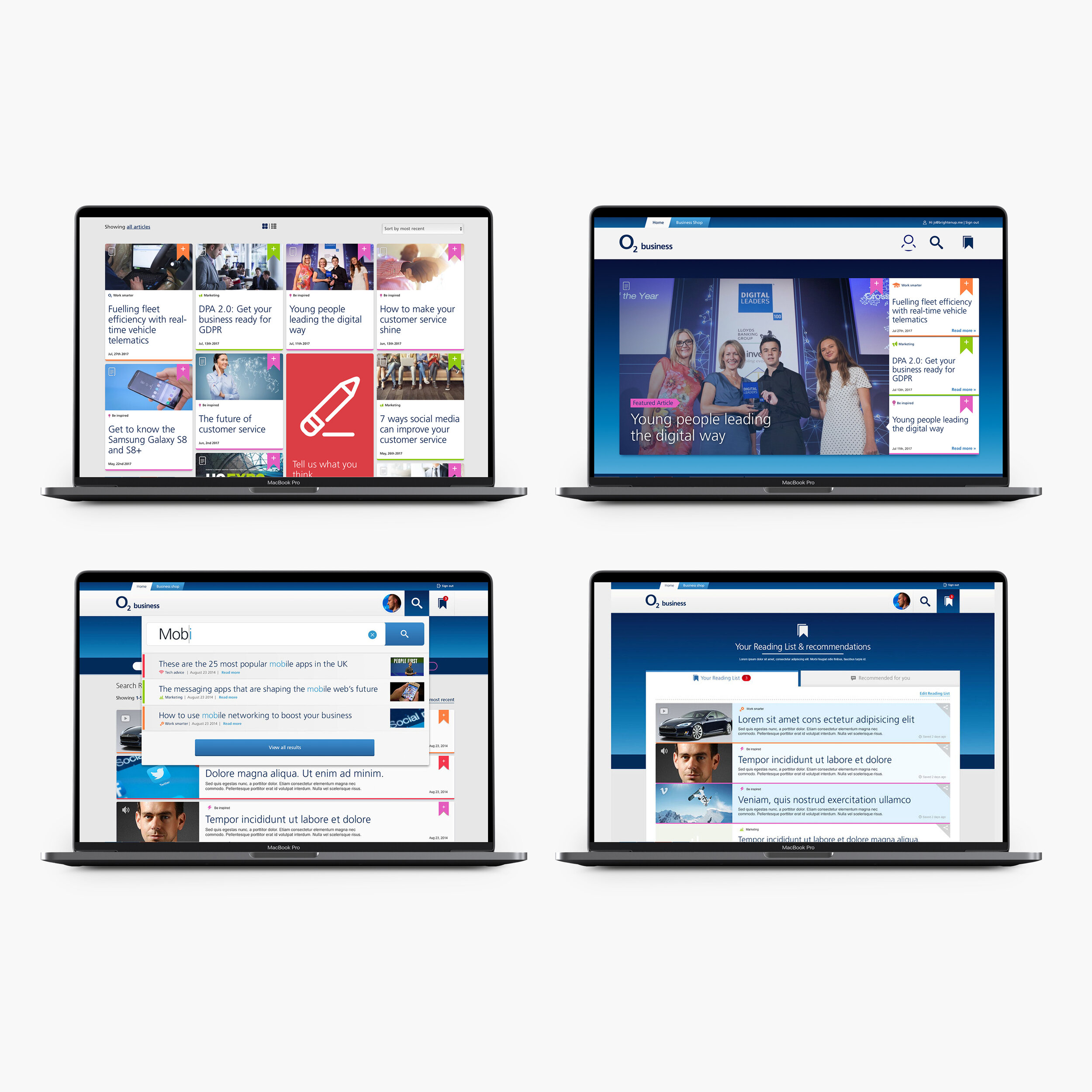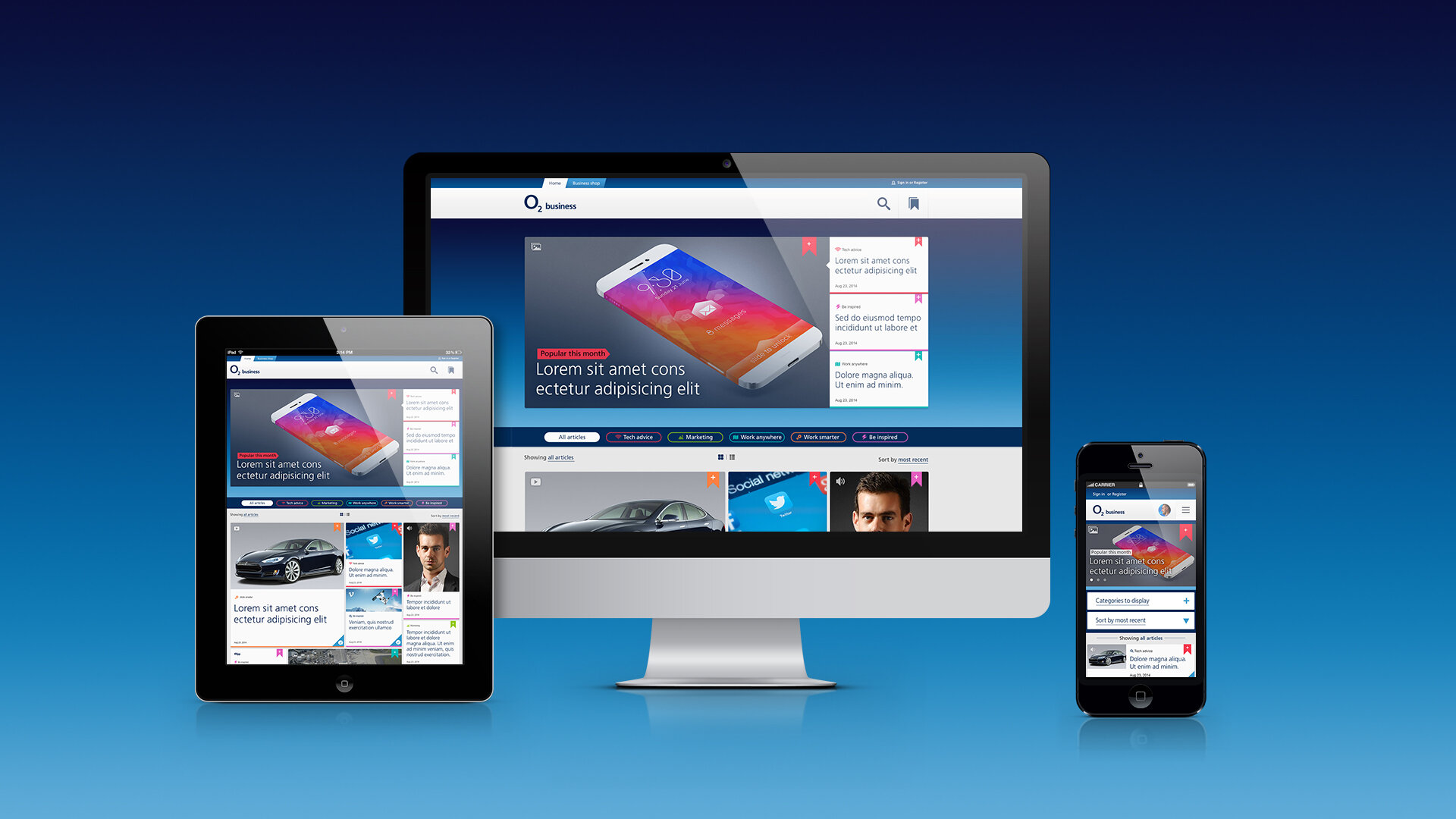Role Experience Design Director
Client O2 Business
Content Design.
How might we create engaging and relevant content that is surfaced in such a way it was useful for small businesses?
Doing business for every small businesses.
O2 wanted to showcase how technology could transform the operations of small businesses. Our goal was to create a platform that not only would provide information, but inspired and advocated for the integration of technology in everyday business practices. This platform needed to demonstrate the unique benefits and support that O2 Business could offer.
Creating engaging and relevant content for small business owners requires understanding their unique challenges, interests, and goals. This involves conducting surveys, interviews, and analyzing forums to identify pain points such as cash flow management, marketing, and compliance. The core assumption being that by understanding and addressing these specific needs, the content will resonate with and engage small business owners effectively and drive engagement.
⚡️Outputs
• Content design
• Design system
• Platform
⚡️Methods
• User-centered design
• Content strategy
• Design research
• Content design
💡The Challenge
Creating such a comprehensive platform presented several challenges
Engagement and relevance The content needed to be engaging and relevant to a diverse audience of small business owners and managers. It had to address the specific pain points and interests of these users while providing actionable insights.
Differentiation The platform had to stand out in a crowded market of online business resources. This meant offering unique value propositions and advanced functionalities that other sites do not provide.
User Experience Design had to intuitive and seamless. And fully responsive and optimized for multiple devices, ensuring accessibility and ease of use for busy professionals.
Content variety and quality The platform needed a mix of content types — videos, articles, interviews, and product demos to cater to different preferences and learning styles.
Personalisation To keep users engaged, the platform needed to offer personalized content recommendations based on users’ browsing behavor and interests. This required tracking and analysis to deliver relevant content without being intrusive.
Technological integration The platform itself had to exemplify the benefits of technology by incorporating advanced features such as quick search functionality, article auto-identification, and a reading list tool etc.
💡Answering the challenge
I started researching the target audience — small business owners. And conducted primary and secondary research to identify the needs and desires of these users. Based on the insights, I crafted a content strategy centered around key themes:
Inspiration Stories of successful businesses that leveraged technology to overcome challenges and achieve growth. This content aimed to motivate and inspire other business owners.
Technology Practical advice and how-to guides on implementing and using various technologies. This included tutorials, tool recommendations, and troubleshooting tips.
Smarter Insights and strategies for improving productivity and efficiency. Topics covered included workflow optimization, time management, and remote working best practices.
Marketing Guidance on using digital marketing tools and strategies to attract and retain customers. This included social media marketing, email campaigns, and content marketing tips.
By focusing to these core subjects, I could ensured that the content was not only relevant but also laid out a foundation for the platform's design — driving key decisions in its development and enhancing its overall effectiveness. This included:
\
Advanced features Recognising the busy schedules of business professionals, the platform included advanced features to enhance user experience. It was mobile-optimised for access on the go without sacrificing content quality. Features like quick search and article auto-identification streamlined content discovery. A reading list tool allowed users to save articles for later, ensuring they could revisit valuable information at their convenience.
Personalised content recommendations Taking content personalisation a step further, I created features to monitor users' reading lists and browsing behaviour to offer tailored content recommendations. This approach moved beyond simple keyword matching to create virtual profiles that provided users with content suited to their specific interests.
Content Variety: The platform was designed to support various media types, such as video interviews, event coverage, image-rich articles, tips, and product demonstrations. This diverse content was presented within a consistent editorial framework using minimal templates and a modular design, ensuring the site remained lightweight and highly flexible.
Practical technology To ensure the platform itself reflected the technological advancements it promoted, I crafter a fully responsive, multi-device optimised platform and supports a various media types, such as video interviews, event coverage, image-rich articles, tips, and product demonstrations. The diverse content is presented within a consistent editorial framework using minimal templates and a modular design, ensuring the site remained lightweight and highly flexible.
The results and impact
By aligning the content strategy with the design approach I was able to create a resource that was not only informative but also highly functional and user-friendly. This relationship between content and design enhancing the overall effectiveness, making it a go-to resource for small business owners seeking to leverage technology for growth and efficiency. The design principles also setting the stage for continuous improvement. Regular feedback from users and ongoing analysis of content performance allowed us to refine and expand the platform continually. This iterative approach ensured that the platform remained relevant and valuable, adapting to the evolving needs of small business owners.
The launch of the O2 Business content platform marked a significant transformation in how small businesses accessed and utilised technology-related information. The user-centric design and personalised content not only enhanced user engagement but also positioned O2 Business as a trusted resource for business innovation. The platform’s advanced features and varied content types attracted a wider audience, fostering a community of informed, tech-savvy business professionals. Ultimately, the initiative solidified O2 Business’s reputation as a leader in driving business efficiency through technology.










